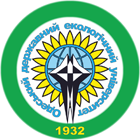Authors: Kruglyak Yu.A., Remenyak L.V.
Year: 2017
Issue: 21
Pages: 105-119
Abstract
General issues of electronic conductivity and the causes for the current flow, role of electro-chemical potentials, Fermi functions, and Fermi window for conduction are discussed, as well as there given detailed description of the Landauer elastic resistor model, different transport regimes from ballistic to diffusion and in between, conductivity modes, and transmission coefficient in the frame of the «bottom – up» approach of modern nanoelectronics. Generalized model of electron transport in the linear response regime developed by R. Landauer, S. Datta, and M. Lundstrom with application to the resistors of any dimension, any size and arbitrary dispersion working in ballistic, quasi-ballistic or diffusion regime is summerized.
In summary, the Landauer equation for the conductivity describes the electron transport in the conductor from the very general positions. The conductivity is proportional to the fundamental constants q and h, which determine the quantum of conductance, associated with contacts. The conductivity depends on the number of modes of conductance and transmission coefficient, representing the probability that an electron with energy E injected by one contact to reach another contact. Conductivity we finally find by integrating the contributions from all modes of conduction. The equations valid for 1D, 2D and 3D conductors for ballistic nanoreactors as well as for massive conductors.
Tags: integrals of the Fermi - Dirac; molecular electronics; nanoelectronics; nanophysics; thermoelectric coefficients; молекулярная электроника; молекулярная электроника; нанофизика; нанофизика; наноэлектроника; наноэлектроника; термоэлектрические; термоэлектрические
Bibliography
- Kruglyak Yu.O., Kruglyak N.E., Strikha M.V. Lessons of Nanoelectronics: Current generation, Ohm’s Law Formulation and Conduction modes in «Bottom – Up» Approach. Sensor Electronics Microsys. Tech, 2012, vol. 9, no. 4, pp. 5-29 (In Ukrainian)
- Kruglyak Yu. O., Strikha M. V. Generalized model of elec-tron transport in micro- and nanoelectronics. Sensor Elec-tronics Microsys. Tech. 2015, vol. 12, no 3. pp. 4–27. (In Ukrainian)
- Kruglyak Yu.O., Strikha M.V. Thermoelectric phenomena and devices in the Kgeneralized model of electron transport.Sensor Electronics Microsys. Tech. 2015, vol. 12, no. 4. pp. 5–18. (In Ukrainian)
- Mark Lundstom, Jing Guo. Nanoscale Transistors: Physics, Modeling, and Simulation. Berlin: Springer, 2006.
- Kim R., Lundstrom M. S. Notes on Fermi–Dirac Inte-grals, arXiv:0811.0116. www.nanohub.org/resources/5475
- Lundstrom M., Jeong C. Near-Equilibrium Transport: Fun-damentals and Applications. Hackensack, New Jersey: World Scientific Publishing Company, 2013, www.nanohub.org/resources/11763.
- Sommerfeld A. An electronic theory of the metals based on Fermi’s statistics. Z. Phys, 1928, vol. 47, no. 1, pp.
- Ashcroft N., Mermin N. Fizika tverdogo tela [Solid State Physics]. Moscow: Mir Publ., 1979.
- Geballe T. N., Hull G. W. Seebeck Effect in Germanium. Phys. Rev., 1954, vol. 94, pp. 1134. .
- Pierret R. F. Semiconductor Device Fundamentals. Reading, MA, Addison–Wesley, 1996.
- Ra Seong Kim. Physics and Simulation of Nanoscale Elec-tronic and Thermoelectric Devices. West Lafayette, Purdue University, 2011.
- Datta Supriyo. Lessons from Nanoelectronics: A New Perspective on Transport. Hackensack, New Jersey: World Scientific Publishing Company, 2012, pp. 473. 2012: www.nanohub.org/courses/FoN1; 2015: www.edx.org/school/purduex.
- Kruglyak Yu.A., Kvakush V.S., Dyadyusha G.G., Khil’chenko V. I. Metody vychisleniya v kvantovoy khimii [Methods of calculations in quantum chemistry]. Kiev: Nauk. Dumka, 1967.
- Glushkov A.V., Kruglyak Yu.A. Quasiparticle Lagrange method in theory of atoms and ions. V kn.: Aktual’nye problemy spektroskopii [In bk: Actual Problems of Spectroscopy]. Moscow: AS USSR, 1985, p. 291. (In Russian)
- Kruglyak Yu.A., Glushkov A.V., Method of calculation of the chemical bond energies and lengths in a model of quasielectrons. Zhurnal fisicheskoy khimii ‒ Journ. of Phys. Chem., 1986, vol. 60, pp. 1259. (In Russian)
- Glushkov A.V. Relativistic and correlation effects in spectra of atomic systems. Odessa: Astroprint, 2006.
- Glushkov A.V., Khetselius O.Y., Svinarenko A. A. Prepe-litsa G. P. Energy approach to atoms in a laser field and quantum dynamics with laser pulses of different shape . In: Coherence and Ultrashort Pulse Laser Emission. Intech, 2010, p. 159. (Ed.: Dr. F. J. Duarte)


